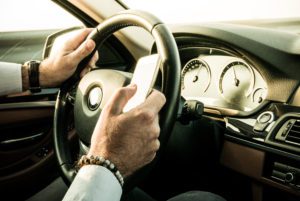 Before you get too upset and refuse to read this article, I’ll ask you to give me just two minutes to explain the situational awareness lesson behind this statement.
Before you get too upset and refuse to read this article, I’ll ask you to give me just two minutes to explain the situational awareness lesson behind this statement.
The first premise is: We must acknowledge (and accept) that it is easy for drivers to get distracted and have their situational awareness impacted while talking on their cell phones and that creates a tremendous hazard for everyone. While talking on their phones, they are often not able to pay much attention to the act of driving and what is happening around them because they are paying attention to the conversation being held on the phone.
Did you get it? They’re not paying attention to the act of driving because their attention is on the phone conversation.
Drivers are not at greater risk because one hand is occupied holding something (in this case, a phone). If distracted driving were caused by something being held on one’s hand, then the law should, technically, forbid drivers from holding ANYTHING in their hand while driving (e.g., food, cup, cigarette, etc.).
Somewhere along the way, lawmakers were led to believe the issue was the phone, being held in the hand, is the distraction. It’s not. The conversation is the distraction, not the device. Let me explain.
When a driver carries on a conversation with someone over the phone, the driver’s brain has to intake, process and comprehend the meaning of the other person’s words. Then, the driver has to also thoughtfully consider how they are going to respond, then formulate and articulate words in return. It seems like such an automatic and effortless process, but it’s not.
The ears have to intake the words, turn the words into electrical impulses, then send those impulses through a series of processes in order for the driver to “understand” what the person on the other end of the phone has said. This takes time and it takes attentional resources in the brain.
It’s important to pause here to note: The time and attentional resources it takes to process a conversation over a cell phone in a car is the same, regardless of whether the driver is holding the phone in their mitt, or whether they are partaking in the conversation hands-free.
And this is why hands-free laws are a bad idea. The law fools complying drivers into believing that for so long as they talk hands-free, they are no longer a distracted driver, and thus, no longer a threat to others.
To say talking on a phone while driving hands-free is safer is equivalent to saying that eating your food with chop sticks will help you control portion size. If you’re scratching your head, thinking that last sentence made no sense, you’re right. It didn’t. And neither does believing talking on a cell phone hands-free will reduce the time and attentional resources needed to comprehend the conversation.
I was going to end the article there. But I know from talking about this so often in my situational awareness classes there will be skeptics who are thinking: Oh really, then why don’t conversations happening between two people who are both in the car produce the same risk?
I understand your skepticism. On the surface, it seems like the same thing, but it’s not. Here’s an example. If two people are in a car together and another motorist pulls out, unexpectedly, in front of the subject vehicle, assuredly, the conversation is going to stop immediately and the driver will be able to shift all attentional resources to avoiding the accident.
However, if the conversation is happening on the phone and the person on the other end of the conversation happens to be talking when the other motorist pulls out in front of the subject car, the person on the other end of the phone has no idea anything has happened and, thus, they will keep on talking.
The person on the other end of the phone doesn’t immediately stop talking and the driver’s brain does not immediately stop listening. Thus, in the driver’s brain, there is a delay in the shifting of attentional resources from the conversation to the impending collision. This increases the driver’s response time. At 40 miles per hour, the driver’s vehicle will travel 58 feet in one second. So, just a momentary delay in the time it takes to shift attention can contribute to a slower response time toward preventing the accident (e.g., swerving and/or braking).
About the Author
Richard B. Gasaway, PhD, CSP is widely considered a trusted authority on human factors, situational awareness and the high-risk decision making processes used in high-stress, high consequence work environments. He served 33 years on the front lines as a firefighter, EMT-Paramedic, company officer, training officer, fire chief and emergency incident commander. His doctoral research included the study of cognitive neuroscience to understand how human factors flaw situational awareness and impact high-risk decision making.
_____________________________________________________

If you are interested in taking your understanding of situational awareness and high-risk decision making to a higher level, check out the Situational Awareness Matters Online Academy.
CLICK HERE for details, enrollment options and pricing.
__________________________________
Share your comments on this article in the “Leave a Reply” box below. If you want to send me incident pictures, videos or have an idea you’d like me to research and write about, contact me. I really enjoy getting feedback and supportive messages from fellow first responders. It gives me the energy to work harder for you.
Let’s Get connected
Facebook: SAMatters
LinkedIn: Rich Gasaway
LinkedIn: Situational Awareness Matters
Twitter: Rich Gasaway
Youtube: SAMattersTV
itunes: SAMatters Radio
Stitcher Radio: SAMatters Radio
Google Play: SAMatters Radio
iHeart Radio: SAMatters Radio
